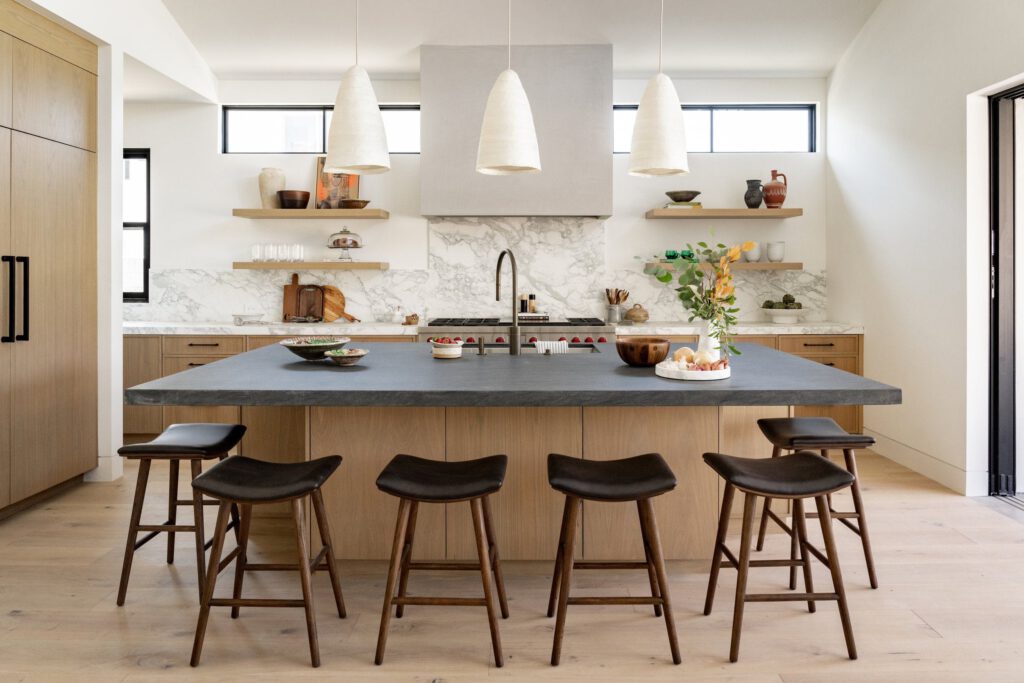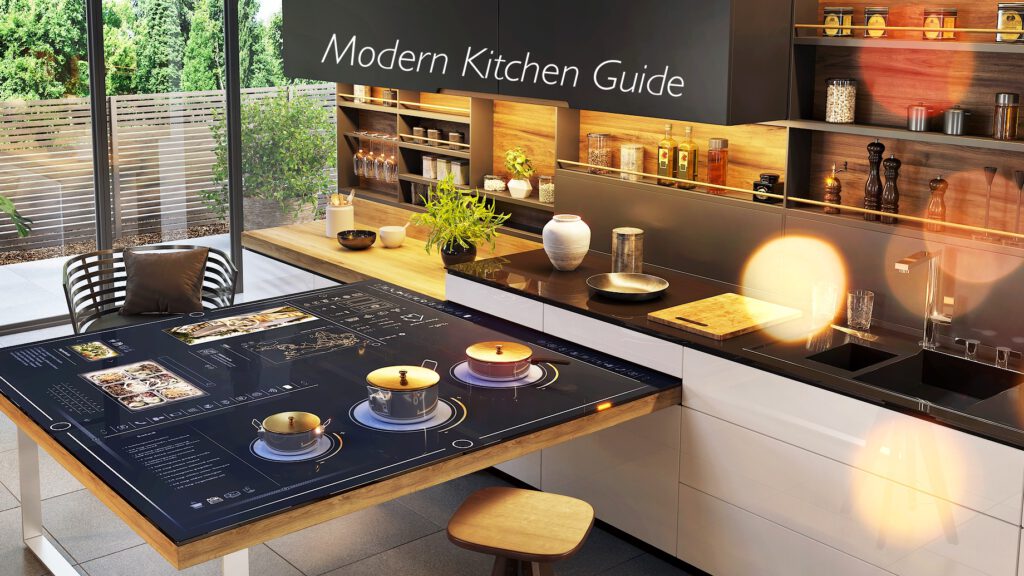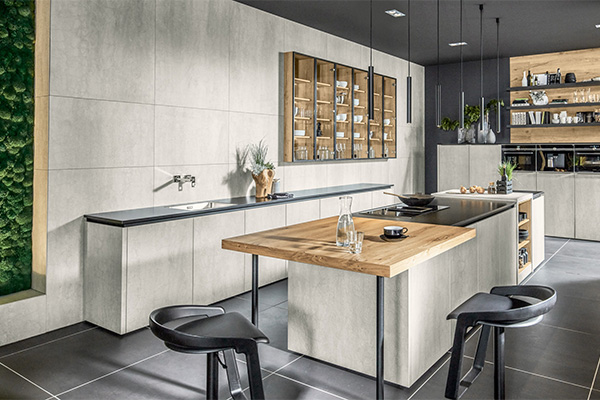Sustainable and eco-friendly materials
Bamboo, recycled glass and reclaimed wood are gaining popularity as options for kitchen countertops in 2023, with reclaimed and recycled materials. They are unique and visually attractive items but also create a more sustainable and eco-friendly kitchen. Other common countertop materials that fit within this trend include granite, quartz, concrete, laminate, and marble. In terms of durability, maintenance needs as well as style considerations homeowners have diverse choices when it comes to countertops.
Energy-efficient appliances and lighting in the kitchen will also characterize 2023 trends where people prefer eco-friendly and low-cost alternatives. Some popular options include LED bulbs which can be found in 65% of kitchens while energy-efficient appliances are present in 61% of homes. Additionally, water-efficient fixtures constitute 34 % while energy-efficient windows are observed in about 27% of all kitchens. Homeowners can save money henceforth by using these green technology products at home.
Low volatile organic compounds (VOC) paints and finishes are another key element of sustainable kitchen design trends for the year 2023 that are ecologically friendly. These products help make indoor spaces healthier by reducing chemical releases into the air. For this reason, designers now increasingly consider incorporating low-VOC paints; more natural light through low E windows; and EPA WaterSense faucets into their kitchen designs. This shift towards healthier and more sustainable materials demonstrates a growing awareness and concern for the well-being of both the environment and the people who live in these spaces.
Smart Kitchen Tech Integration

One of the major trends in kitchen design in 2023 will be voice-activated assistants integrated with home appliances. As technology evolves, individuals have become more innovative on how to use it most practically at home especially when it comes to modernizing their kitchens. Amazon Alexa, Google Assistant or even Apple Siri could all be used as voice-activated assistants to control smart devices or other Internet-of-Things (IoT) based systems in the kitchen, such as ovens and fridges. The benefit of this is that users can change temperature settings, set timers, and even search recipes without lifting a finger. This hands-free approach to kitchen tasks not only saves time and effort but also enhances the overall cooking experience.
Automated meal planning and grocery shopping is another upcoming trend in kitchen design for 2023. These systems use advanced software with artificial intelligence (AI) capabilities to analyze the user’s food preferences and nutritional needs, as well as the available ingredients to produce personalized menus and shopping lists. Such high-level automation makes it easier for homeowners to stick to their diets while reducing the wastage of foodstuff as well as minimizing the burden of carrying groceries from shops. Furthermore, integrating these homes with smart kitchens can help simplify the cooking process significantly since appliances are capable of adjusting their properties automatically whenever they receive commands from selected recipes.
In 2023 kitchens will be transformed by multi-functional, interconnected devices that make meal prep and cooking more convenient and efficient. Often, these appliances are capable of serving as a slow cooker, pressure cooker, air fryer and many others within one small device. Homeowners can save scarce bench space and storage areas by combining some functions in one gadget. Such appliances can also be managed remotely through smartphone apps or voice assistants – making them more convenient and flexible. In future, there will be more innovative multifunctional gadgets designed to suit the growing need for smart kitchen technology.
Innovative storage solutions
The 2023 kitchen has been adopting creative storage solutions such as custom pantry organizers. Homeowners use these systems to keep their groceries, utensils, and other necessary items in an organized manner. The customized pantries consider the homeowner’s individual needs and tastes by giving them a uniquely designed system which maximizes storage while maintaining style and aesthetics. Some of the key features that are found in customized pantry organization systems include: – Adjustable shelves that can accommodate various sizes of things. – Pull-out drawers and baskets- they are easily accessible for keeping those things we often use at home. – Built-in dividers are used to separate items from each other so that they do not mingle within a single space.
Another trendy style in designing a 2023 kitchen concerns itself with optimized utilization of cabinets or shelf spaces provided in the building plan. As people increasingly seek to make better use of available spaces in modern kitchens by finding more ways where storage can be kept looking stylish, designers have gone all out to develop innovative techniques aimed at attaining this objective without compromising style. Examples of some space-saving cabinetry and shelving options include: – Corner cabinets fitted with rotating shelves that put the otherwise useless angles into good use – Pull-out cabinets for narrow spaces where it is difficult to reach stored goods – Vertical cases like pegboards, wall-mounted racks which free up countertop areas – Open shelving for displaying frequently-used materials.
Furthermore, hidden appliances and integrated machines are among the top trends in kitchen design in 2023; this means integrating refrigerators, dishwashers, microwaves etc seamlessly into the overall design of kitchens sometimes behind custom cabinetry or even integrated into countertops or islands. This results in a sleek minimalist look offering many benefits such as: – A tidy attractive place that stresses clean lines and modern looks. – Better efficiency since built-in appliances tend to have advanced technology that works well with other parts of the kitchen – More functionality because obscure machines will save you considerable working space on the countertop and floor in the kitchen.
Faqs
Q: What are the trendiest, most sustainable materials for kitchen countertops in 2023?
A: Kitchen design has taken sustainability as its central theme where homeowners and designers are finding solace in materials that are friendly to the environment. The top choices include reclaimed wood, recycled glass, plus composite countertops made from post-consumer paper or plastic. Not only are they environmentally friendly but offer different finishes to the tops of the kitchen. On top of that, they can be long-lasting at times more than traditional granite and marble.
Q: How can I make my kitchen more energy-efficient?
A: For an energy-saving kitchen, get Energy Star-rated appliances that use less power without compromising performance. LED lights also serve a good purpose since they consume much less electricity and last longer than traditional incandescent bulbs. Besides this, you can opt for using paints and finishes low on VOCs (Volatile Organic Compounds), which better indoor air quality. Thoughtful design maximizes natural lighting hence reducing artificial one during the day
Q: What types of smart technology can be integrated into modern kitchens?
A: In 2023, there is a variety of smart devices used in cooking and improving general functionality within your home. Voice-controlled aids provide help with things like setting up timers, building shopping lists or even controlling smart devices for instance cooking pots. Smart fridges have an expiry date tracker and grocery inventory management while intelligent cookers can be heated before arrival or fed with recipes remotely. On top of this, there are meal planning services run by machines which take into consideration your dietary requirements while working out what ingredients you have in store; it may also order foodstuffs exactly needed for certain dishes.
Q: How are storage solutions evolving in kitchen design?
A: Storage solutions for 2023 revolve around designs that maximize space efficiency and functionalism. In-built pantry organization systems allow homeowners to customize their shelves according to their individual preferences including adjustable brackets, baskets slides and even countertop areas within pantry units for small kitchen appliances. There are also space-saving cupboards like corner or kickboard drawers or vertical dividers for baking trays and chopping boards. Furthermore, there is a new trend where refrigerators, dishwashers and other appliances are built into cabinets so that they do not look out of place.
Q: What are some examples of hidden and integrated appliances in kitchen design?
A: Hidden and integrated kitchen gears are designed to blend in with cabinetry or walls thereby refining the appearance of your house. This consists of refrigerators and dishwashers that come with similar frontal parts as the rest of the kitchen cupboards hence blending perfectly when placed next to other storage spaces. Other common ones include microwave drawers, built-in coffee makers, and pop-up range hoods. When not being used these tools can be concealed which makes a simplistic uncluttered-looking room. As a result, this fashion not only makes it more attractive but also frees up floor and countertop areas giving it a rather functional usefulness





